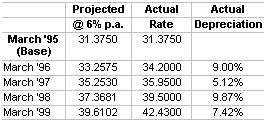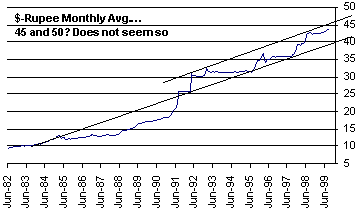|
September 8, 1999
COMMENTARY
INTERVIEWS
USEFUL INFO
CREDIT POLICY
BUDGET 1999-2000
ARCHIVES
SEARCH REDIFF
|
The Rediff Business Special/Vikram Murarka
Rupee remains a good buy
 Some sections of the foreign exchange market and the media have long held onto the belief that "the Rupee is destined to depreciate six per cent per annum till kingdom come". Data tabulated alongside indicates whether or not the market has supported this belief.
Some sections of the foreign exchange market and the media have long held onto the belief that "the Rupee is destined to depreciate six per cent per annum till kingdom come". Data tabulated alongside indicates whether or not the market has supported this belief.
If March 1995 is taken as the base rate, the Rupee has depreciated much more than it was supposed to, till March 1999. In fact, the Rupee has depreciated at an average rate of 7.85 per cent per annum.
At six per cent per annum, March 2000 should be 44.98 (base March 1999) to the US dollar, a rate which is already available on the forward market. At 7.85 per cent per annum, the Rupee ought to be 45.76, which seems to be very difficult to achieve.
 The "six per cent per annum" mantra is based on the theory of inflation differentials and the Purchasing Power Parity Theory. These are antiquated theories which do not work in the case of India because the Rupee's fortunes are impacted much more by capital flows than by trade flows.
The "six per cent per annum" mantra is based on the theory of inflation differentials and the Purchasing Power Parity Theory. These are antiquated theories which do not work in the case of India because the Rupee's fortunes are impacted much more by capital flows than by trade flows.
Yet, at a seminar last week, a leading foreign bank is reported to have predicted a level of 45.00 for the Rupee by March 2000. Forecasts like that have been made religiously every year for the past three years. Foreign exchange traders have grown tired of such forecasts because they have not come true so far.
 The graph alongside suggests that the Rupee does not seem to be in any hurry to climb to the 45.00 level. And a level of 50 seems to border on the impossible, unless we see a devaluation of the kind seen in 1991. Or this may happen if a full-fledged Indo-Pak war breaks out.
The graph alongside suggests that the Rupee does not seem to be in any hurry to climb to the 45.00 level. And a level of 50 seems to border on the impossible, unless we see a devaluation of the kind seen in 1991. Or this may happen if a full-fledged Indo-Pak war breaks out.
The Rupee continues to get very poor discounting. Its future earning potential justifies a higher discounting. It has been, and continues to be, a good buy.
Who can buy the Rupee? Foreigners. (Indians cannot buy it, they have to earn it.) For what purpose can foreigners buy the Rupee? To invest, in India.
Again, unless there is a war, or the Dow Jones Industrial Average falls below 9,500 (on September 7 it was at 11,078), the BSE Sensex has the potential to double to around 10,000 in 12 months time. In such a scenario, foreign institutional investors would find it very difficult not to buy rupees.
Believers in the Great India Dream who are willing to invest in that dream would be natural buyers of the Rupee. And they may be well rewarded for their dreams.
Footnotes: In the words of Prof Rudiger Dornbusch and Stanley Fischer of the Massachusetts Institute of Technology, "The Purchasing Power Parity Theory of the exchange rate argues that exchange rate movements primarily reflect differences in
inflation rates between countries."
While the professors go on to enumerate the conditions where the
theory does not seem to work, our attention should be on the word
"primarily". The theory says that of the various factors affecting
exchange rates, inflation differential is the most important. Why is the
theory considered antiquated? It first came
into being in a world where foreign exchange transactions were undertaken,
for the greater part, for trade purposes (exports, imports). In
today's world, foreign exchange transactions are undertaken for: a)
trade purposes; b) capital investments and divestment purposes;
and c) speculation purposes.
For the major currencies, there is no doubt that the third purpose
accounts for more than 60 per cent of the total forex transaction volumes.
In the case of the Rupee, the RBI has successfully cut the
speculation out of the market. But, it cannot be denied that the
Rupee is much more affected by capital flows than by trade flows.
Hence, there is more to the Rupee-Dollar exchange rate than just
inflation differentials. Back to the story.
Devaluation: Technically, the Rupee cannot be devalued any more. The
exchange rate is determined by the market. It is not a rate given to
the market every day by the RBI, as was the situation prior to 1991.
It is another matter that the RBI micro-manages the rate and the
market. The point is, it has to do so either as a market participant
itself or through other market participants like State Bank of India.
The Rupee cannot be devalued 20 per cent overnight by the stroke of a
pen. Back to the story.
The writer is director, Kshitij Consultancy Services, and a Calcutta-based forex analyst.
Rupee will strengthen further, say experts
Specials
Business news
|

